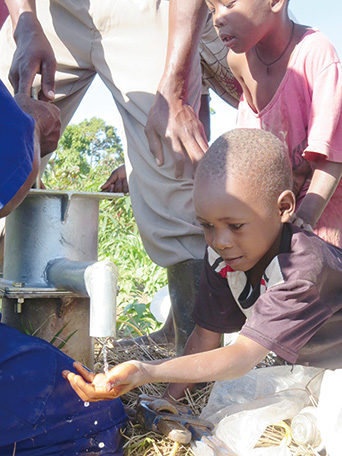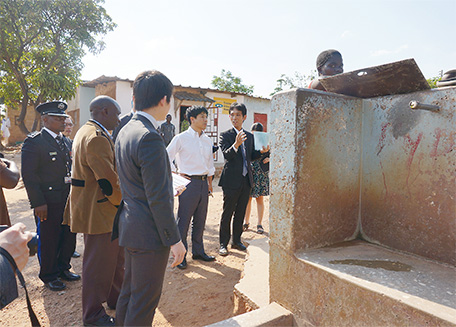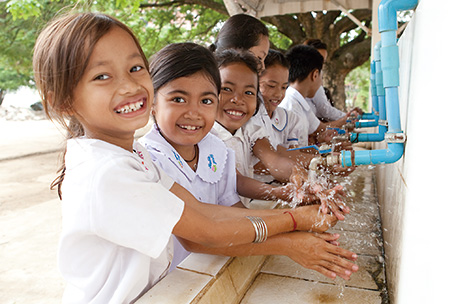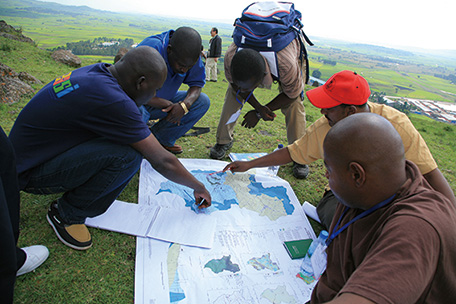(3) Water and Sanitation

A Japan Overseas Cooperation Volunteer (rural community development officer), Mr. Yasushi Yoda repaired a broken well that was unable to pump up water with the local residents in Uganda. “Water came out for the first time in two years!” At that moment, a child reached out his hand for water. (Photo: YasushiYoda)
Water and sanitation is a serious issue related to human life. In 2012, approximately 748 million people worldwide had no access to safe drinking water such as water supply or wells and approximately 2.5 billion people—about a half of the population of developing countries—had no access to basic sanitation such as toilet and sewage systems.(Note 4) More than 11% of children under five years old lose their lives due to diarrhea caused by a lack of safe water and basic sanitation facilities.(Note 5)
< Japan's Efforts >

Parliamentary Vice-Minister for Foreign Affairs Kazuyuki Nakane visiting the water supply facility in Ng'ombe compound in Zambia, which was developed through the Japanese grant aid.

Students washing their hands with tap water in a primary school in Cambodia. Water supply infrastructure in this region was developed through support from Japan. (Photo: Shinichi Kuno / JICA)
At the Fourth World Water Forum in 2006, Japan announced the Water and Sanitation Broad Partnership Initiative (WASABI). Japan's disbursements of aid for water and sanitation are the largest in the world. Japan provides comprehensive support for both the knowledge and expertise as well as the equipment and facilities based on Japan's experiences, knowledge, and technology in the following: (i) promotion of integrated water resources management; (ii) provision of safe drinking water and basic sanitation (improvement of sanitation facilities); (iii) support regarding water use for food production and other purposes (e.g. water for agricultural use); (iv) water pollution prevention (establishing effluent regulations) and ecosystem conservation (conservation of vegetation and sustainable forest management, etc.); and (v) mitigation of damage from water-related disasters (establishment of an early warning system and strengthening the disaster response capacities of individuals and local communities).
In December 2010, Japan led the adoption of the U.N. General Assembly Resolution on the follow-up of the International Year of Sanitation (2008), and is supporting global efforts to achieve “Sustainable Sanitation: Five-year Drive to 2015,” towards 2015, the target year to achieve the MDGs.
Since TICAD IV in 2008, Japan has been promoting the development of water and sanitation facilities, and by 2012 it has: (i) implemented grant aid and loan aid projects to provide safe drinking water to 10.79 million people; and (ii) provided support for the capacity building of more than 13,000 managers and users in the field of water resources (including the relevant personnel in the water management cooperative association of villages).
In addition, at TICAD V in June 2013, Japan announced that it would continue providing support for ensuring access to safe drinking water and basic sanitation facilities for approximately 10 million people for a period of five years, as well as provide support for fostering 1,750 urban waterworks engineers.
- Note 4: Source: “Progress on Drinking-Water and Sanitation: 2014 Update” (WHO/UNICEF)
- Note 5: Source: “Committing to Child Survival: A Promise Renewed” (UNICEF, 2012)
| Ethiopia
The Ethiopian Water Technology Center Project
Technical Cooperation Project (January 2009 – November 2013)

Field work for an underground water model course. Participants are using a map to confirm the knowledge they learned in the training. Planning an appropriate underwater model is essential for efficiently drilling a well. (Photo: JICA)
In Ethiopia, more than 80% of the population lives in rural areas. However, their water supply coverage1 is 44%, significantly lower than the average coverage of 64% of Sub-Sahara African countries. Considerable time and effort are required for the Ethiopian people to obtain water, and this has become a factor hindering poverty reduction in the country. It is thus all the more important that engineers working to secure safe water are adequately trained, in order to enhance people's access to safe water.
For 15 years since 1998, Japan provided technical cooperation to the Ethiopian Water Technology Center (EWTEC). In doing so, Japan provided support for the establishment and implementation of permanent training courses and for the operation of the EWTEC, focusing especially on the training of technical advisers. First, from 1998 to 2005, Japanese experts played a leading role in the implementation of these trainings. Then, from 2005 to 2008, this role began to be handed over to the Ethiopian side. By the time the project entered the final phase (2009 to 2013), the Ethiopian side was able to implement most of the training courses independently.
The EWTEC has thus far accepted a total of more than 3,500 trainees from Ethiopian governmental agencies, private companies, vocational training schools, and other organizations. The trainees who completed the courses are today playing key roles throughout Ethiopia. In addition, the EWTEC organizes international training courses for engineers from surrounding African countries (18 countries), contributing to the training of groundwater engineers not only in Ethiopia, but also in a wider area of Africa.
In recognition of its achievements, in August 2013 the EWTEC was officially approved as a national institution and was renamed the Ethiopian Water Technology Institute (EWTI). This formally established the EWTEC, now the EWTI, as the central organization in Ethiopia for training engineers in the water sector. As a new organization, the EWTI is expected to contribute to the further development of the water sector in Ethiopia and to increase people's access to safe water.
*1 The proportion of the population with access to safe water supply.
